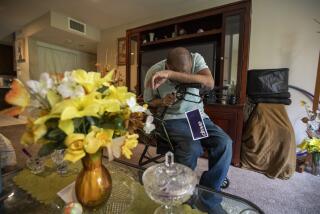Time Running Out for 8-Year-Old Who Needs Transplant
- Share via
ORANGE — Amy Aronson loves bicycle riding, so when the 8-year-old Laguna Hills girl won a mountain bike in a school coloring contest she was ecstatic.
But since its January delivery, the bike has sat unused as Amy has grown ever weaker from the debilitating effects of cystic fibrosis, a genetic disease that causes respiratory infections and gradually weakens the entire body.
She is now hospitalized, awaiting a heart-lung transplant that may mean new life.
Her parents, Linda and Richard Aronson, have maintained a bedside vigil at Children’s Hospital of Orange County, hoping to receive word that the operation can proceed. But donor organs are scarce.
Even though Amy tops the waiting list for her size, in the eight days since she was placed on two organ procurement lists that cover Southern California there has been no word of a prospective donor.
For the Aronsons, it is an agonizing time because they know that 20% to 30% of all transplant candidates die before a suitable organ can be found.
They are hoping that anyone who knows or suspects that matching organs may become available--such as from the victims of traffic accidents--will call local transplant registries. But their plea is not only for their daughter.
It’s crucial that people are reminded of “how important it is to consider donating their organs,” said Richard Aronson, a Superior Court commissioner.
Amy’s condition was diagnosed when she was 2, her father said. Although there is no cure for the disease, victims can be treated with antibiotics.
Though many children are able to lead normal and long lives with treatment, Amy’s case is much more severe than most.
She used to run and play like any girl, said Richard Aronson. She would get dizzy and have terrible headaches, but that did not stop her from chasing her younger brother, Richie, now 6, around the house. She took ballet lessons. Bright and outgoing, she is an “A” student.
“But gradually those things fell by the wayside,” her father said.
Eventually, the antibiotics failed to stem the secretion of mucus that choked her lungs. Since the beginning of the year, “she has had to wear oxygen masks more often, she couldn’t walk, then she needed a wheelchair,” he said.
She now weighs about 40 pounds, said Dr. Ralph Rucker, director of pediatric pulmonary services at Children’s Hospital. Without a transplant, which she would undergo at UC San Diego, she may have only one or two weeks to live.
“She’s in very critical condition. She has major difficulty in breathing,” Rucker said. “It’s not ‘maybe’ or ‘perhaps.’ She will not survive without a transplant.”
There have been fewer than 100 combined heart-lung transplants performed in the United States, said Dr. Stuart Jamieson, a leading transplant surgeon and chief of cardio-thoracic surgery at UCSD.
About a half-dozen people who need combined transplants are on the UCSD waiting list, including Amy, Jamieson said.
The UCSD program has about an 80% survival rate after one year for the combined operation. The problem remains one of finding donor organs. Under California law, hospitals are required to approach the families of potential organ donors, but the need still far outstrips the supply, Rucker said.
Rucker and Aronson want to remind people that much good can often be retrieved from tragedy.
“If I had a chance to donate my children’s organs to someone, it would seem a way for them to live on,” Aronson said. “If I could contribute to helping someone else live, it would be special to me.”
Anyone who wants more information or knows of prospective donor organs may call the California Heart Transplant Center in San Diego at (619) CA-HEART or the Organ and Tissue Acquisition Center, also in San Diego at (619) 294-6263.
More to Read
Sign up for Essential California
The most important California stories and recommendations in your inbox every morning.
You may occasionally receive promotional content from the Los Angeles Times.











